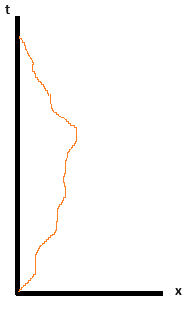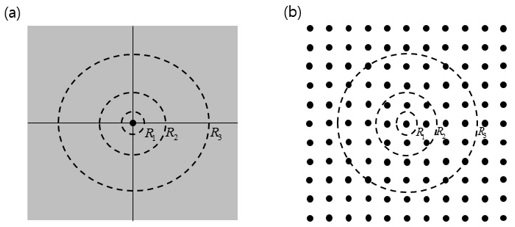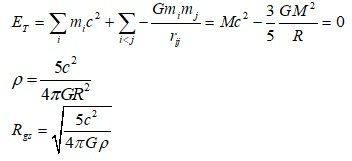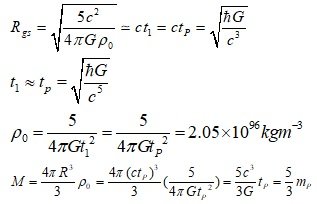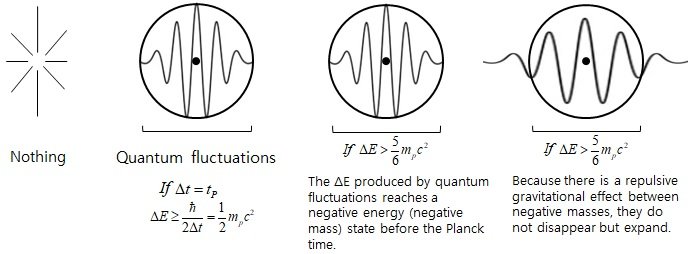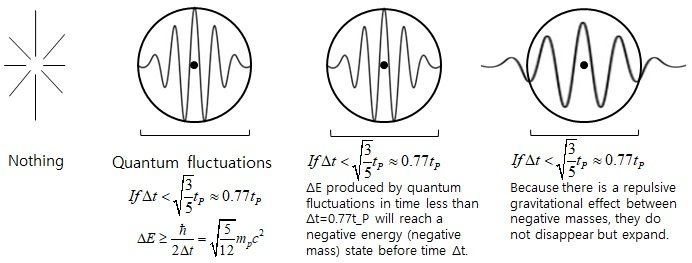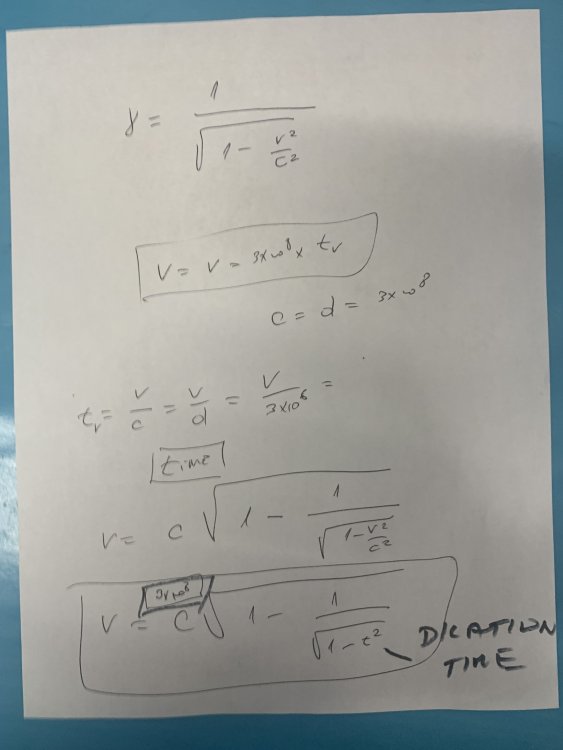Search the Community
Showing results for 'time travel'.
-

How does a physical system evolve under acceleration?
Genady replied to geordief's topic in Relativity
Yes. The time dilation does not happen at some event or events along the ship's worldline, but rather accumulates along the entire worldline. You can have a wild worldline with accelerations, decelerations, turning back and forth, etc., like this, for example: You divide that line into infinitesimal straight segment. On each segment, the proper time of the traveler is \[d \tau^2 = dt^2-dx^2\]. Then you integrate, \[\int{d \tau}\] to obtain the total time of the travel on the traveler's clock. Just a matter of calculation, see above. -

How does a physical system evolve under acceleration?
Genady replied to geordief's topic in Relativity
It is wrong to assume that physical processes during acceleration are responsible for the time dilation. Time dilation is a geometrical rather than a physical effect. It is caused by the geometry of Minkowski spacetime. Let me describe the "twin's paradox" when nothing happens during an "acceleration". There is a clock located at 4 lh (light-hours) from Earth which is synchronized with the clock on Earth. Let's call this point in space, T. A ship moves with the speed 0.8c past the Earth. At the moment when a clock on the ship passes the clock on Earth, it is set to whatever is the time on Earth. Let's say, 10:00. The ship reaches the point T in 4/0.8=5 hours in the Earth time. The clock in T, which is synchronized with the clock on Earth, shows 10:00+5=15:00 when the clock on the ship passes it. However, the clock on the ship shows at this exact point in spacetime, i.e., as the two clocks are side-by-side, 10:00+3=13:00, because the time dilation factor for the speed of 0.8c is 0.6, and thus the trip to the point T takes 5*0.6=3 hours in the ship time. At the same exact point in spacetime, another ship passes the point T, going toward the Earth with the speed 0.8c. They grab the ship's clock and take it back to Earth. This trip back takes the same 5 hours in the Earth time and the same 3 hours in the ship time. So, when the clock returns to Earth, the clock on Earth shows 10:00+5+5=20:00, while the returned clock shows 10:00+3+3=16:00. Done. -
Forest fires are not burning fossil fuels. Forests will grow again, so any CO2 released is offset by growth somewhere. Fossil fuels represent sequestered carbon, stored over many millions of years but released over a much shorter time, and much faster than natural processes could store it again. It is because we were burning fossil fuels that these rates aren’t the same. It didn’t start with the invention of fire - it started with the large-scale burning of sequestered carbon. Most of the time before the industrial era back for hundreds of thousands of years, the CO2 levels were lower than at the outset of the industrial era
-

The simplest cause of the accelerating expansion of the universe
joigus replied to Max70's topic in Speculations
Not really. A gravitational orbit plus a dissipative environment will be a possible model to account for closing spiral orbits, as @exchemist has pointed out. It just doesn't seem to do what you claim it does. I would relax about getting credit for this idea for the time being. -
I'm a little late, I think all aspects are sorted out already. But I had started drawing a picture of different aspects of the relative velocities in the scenario. Posting in case anyone finds it helpful: Rocket A is traveling from space station a at velocity VAa (Aa denotes that the velocity is the relative velocity between a and A) Rocket B travels from station b at velocity VBb . The rockets will meet head on and VAa=-WBb Equations: 1: a and b (the space stations) are at rest relative one another, in the same inertial frame of reference 2: When each rocket's crew measures the velocity of the other approaching rocket, relative to their own rocked, the velocity does not match the sum of velocities relative their starting points. (Assuming the correct sign is used since velocity is vector) 3: for low speeds the sum of velocities is a reasonable approximation 4: Rocket A will measure its speed relative its starting point to be the same (with negative sign) as the rocket B will measure relative it's starting point 5: Rocket A will measure leaving a with the same velocity that it is approaching b (minus the sign) 6: In any case the relative velocities between the rockets, measured by crew on board A, is greater than the rocket's velocity relative it's starting point a (and symmetrical for rocket B and crew) 7 (now shown) observers on a or b will agree that the rockets will meet half way between a and b. The sum of distance traveled by A plus B can be more than a light signal could travel in the same amount of time. (did this in a bit of a hurry between other things, please point at errors)
-
I understand what you seem to be trying to say. I am trying to help you use consistent terminology to do so. You've been saying ped1 is stationary and immediately saying he has a nonzero speed. That's a contradiction, and it has to be fixed. Motion is relative, and ped2 is your designated reference. If motion is specified relative to anything other than ped2, you need to explicitly say this, else the statement is not even wrong. It renders further discussion impossible. Your scenario seems to take place at an airport with moving sidewalks. Ped2 is standing outside of one of them, and ped1 is standing on the sidewalk. Sometimes the sidewalk is on (cases 2 & 3) and sometimes off (case 1). The points in space (A-F) are all locations relative to Ped2, not relative to anything else. Oh, that's much better. You added 'relative to the road', which is the alternate frame reference that was missing before. Now it's not a contradiction. This part is still contradictory. You said it takes 2 seconds to do the two diagonals, one second apiece. Now you assert a different time of 2.8 s. That's a contradiction. It takes 2 seconds to go 2.8 meters at 1.4 m/sec which is the speed ped1 is moving relative to ped2. You also get units wrong. You multiply 1.4 seconds by two, which should get 2.8 seconds, but you call it 2.8 meters. I suspect the unit thing is just a typo. This is still wrong. Ped1 moved from A to D in one second, and that distance is 1.4 m, so his speed relative to Ped2 is 1.4 m./sec, not 1. You did not show your calculation of from where this 1 m/s comes. It really doesn't matter if he's aware of how ped1 is accomplishing his motion. Point is, he sees him 1.4m away after 1 second, and his speed is thus 1.4 m/sec, regardless of what the road is doing. You seem to think it does matter, and that a ped3 doing the same thing with a jetpack, but always being at the same location as ped1, is somehow moving at a different speed relative to Ped2. This is wrong. If you insist otherwise, well then perhaps this topic needs to be moved to strange claims section. This is really hard to parse, but apparently you've imposed a speed limit of 1, and the road moves incredibly slow. I think this is an attempt to an analogy of using natural units for speed rather than m/sec, but given your inability to describe simple Newtonian motion above, I think I won't go there and take your description as worded. "The pedestrian one is 0.7m wide" : What does that mean? He is now on a somewhat narrower super-slow moving sidewalk? Legal, but why? The road speed cannot be 0.1m since meters is not a unit of speed. You perhaps mean 0.1m/sec, so it moves perceptibly fast now. I think a typical airport sidewalk goes about 2 m/sec, but we're in the slow and safe airport today. Why the speed limit? Relative to what? Ped2? What if ped2 decides to walk left? Can nobody put a box on the sidewalk now? What prevents it? How very non Newtonian. The abrupt change of velocity at point D is straight downward (south), so the jet pack should be pointing south, not to the southeast as drawn. Better to just put a wall at D and have him bounce off it. No jet pack needed at all then. He can just be an inertial object in freefall the whole time.
-
I only have so much time in my life. Applying my theory to all physics branches and reexamining the basis of all physics is on my to-do list. You have to start somewhere. It would go a lot quicker for me if I didn't meet with so much senseless cynicism and unwillingness to explore simple concepts first. You won't take the time to learn what I am presenting, and instead, your reaction is to deny anything you do not already know. Have you heard the lament about people who are smart but not intelligent? Set aside your to-do list of questions you want to be answered for the moment. Instead, look at my presentation and see if it warrants further development. Perhaps you will discover insights or fix genuine problems in my theory. I have presented several potentially ground-breaking insights in this thread. You have not looked into any of them. Just because I haven't figured out why Holstein cows have black and white spots instead of green and yellow is something we can discuss later. Diversions are irrelevant to the concepts being presented at this moment.
- 72 replies
-
-2
-
One of humanity's ultimate questions is "How did the universe come into existence?" Since energy is one of the most fundamental physical quantities in physics, and particles and the like can be created from this energy, this question is "How did energy come into existence?" It is related to the question you are asking. Cosmology can be largely divided into a model in which energy has continued to exist and a model in which energy is also created. Each model has its strengths and weaknesses, but in the model that assumes the existence of some energy before the birth of our universe, "How did that energy come into existence?" Since the question still exists, the problem has not been resolved and, therefore, I do not personally prefer it. In order to explain the source of energy in our universe, there have been models that claim the birth of the universe from nothing, or a Zero Energy Universe. However, the key point, the specific mechanism of how being was born from nothing, is lacking, presupposes an antecedent existence such as the Inflaton Field, or is described in a very poor state. *The nothing mentioned here is not a complete nothing, but a state of zero energy. I would like to suggest a solution to this ultimate problem. 1. Changes in the range of gravitational interactions over time In Figure 1, if the mass-energy within the radius R_1 interacted gravitationally at t_1 (an arbitrary early time), the mass-energy within the radius R_2 will interact gravitationally at a later time t_2. As the universe ages, the mass-energy involved in gravitational interactions changes, resulting in changes in the energy composition of the universe. The total energy $E_{T}$ of the system is a [math] {E_T} = \sum\limits_i {{m_i}{c^2}} + \sum\limits_{i < j} { - \frac{{G{m_i}{m_j}}}{{{r_{ij}}}}} = M{c^2} - \frac{3}{5}\frac{{G{M^2}}}{R} [/math] b <math> {E_T} = \sum\limits_i {{m_i}{c^2}} + \sum\limits_{i < j} { - \frac{{G{m_i}{m_j}}}{{{r_{ij}}}}} = M{c^2} - \frac{3}{5}\frac{{G{M^2}}}{R} </math> c [tex] {E_T} = \sum\limits_i {{m_i}{c^2}} + \sum\limits_{i < j} { - \frac{{G{m_i}{m_j}}}{{{r_{ij}}}}} = M{c^2} - \frac{3}{5}\frac{{G{M^2}}}{R} [/tex] Since there is an attractive component (Mass-energy) and a repulsive component (Gravitational potential energy or Gravitational self-energy), it contains elements that can explain the accelerated expansion and decelerated expansion of the universe. In the case of a uniform distribution, comparing the magnitudes of mass energy and gravitational potential energy, it is in the form of -kR^2. That is, as the gravitational interaction radius increases, the negative gravitational potential energy value becomes larger than the positive mass energy. 2. The inflection point at which the magnitudes of mass energy and gravitational potential energy are equal The inflection point is the transition from decelerated expansion to accelerated expansion. If R < R_gs , then the positive mass-energy is greater than the negative gravitational potential energy, so the universe is dominated by attractive force and is decelerating. If R > R_gs, then the negative gravitational potential energy is greater than the positive mass-energy, so the universe is dominated by the repulsive (anti-gravity) force and accelerated expansion. Therefore, by matching R_gs with the time of accelerated expansion in the early universe, we can create a new inflation model. 3. When entering accelerated expansion within the Planck time This means that, in Planck time, a universe born with an energy density of ρ_0 passes through an inflection point where positive energy and negative gravitational potential energy (gravitational self-energy) become equal. And, it means entering a period of accelerated expansion afterwards. 4. Birth and Expansion of the Universe from the Uncertainty Principle 4.1 The Uncertainty Principle - Inflating in Planck time During Planck time, fluctuations in energy During Planck time, energy fluctuation of ΔE=(1/2)m_pc^2 is possible. However, when the mass distribution of an object is approximated in the form of a spherical mass distribution, Δx from the uncertainty principle corresponds to the diameter, not the radius. So Δx=2R'=cΔt, this should apply. In this case, from the values obtained above in "When entering accelerated expansion within the Planck time", the density is quadrupled, the radius is 1/2 times, and thus the mass is (1/2) times. Therefore, the mass value is M'=(5/6)m_p It means, If Δt occurs during the Planck time t_p, the energy fluctuation ΔE can occur more than (1/2)m_pc^2. And, the energy of the inflection point where the mass distribution enters accelerated expansion is (5/6)m_pc^2. In short, According to the uncertainty principle, it is possible to change (or create) more than (1/2)m_pc^2 energy during the Planck time, If an energy change above (5/6)m_pc^2 that is slightly larger than the minimum value occurs, the total energy of the mass-energy distribution reaches negative energy, i.e., the negative mass state, within the time Δt where quantum fluctuations can exist. However, since there is a repulsive gravitational effect between negative masses, the corresponding mass distribution expands instead of contracting. Thus, the quantum fluctuations generated by the uncertainty principle cannot return to nothing, but can expand and create the present universe. 4.2. The magnitude at which the minimum energy generated by the uncertainty principle equals the minimum energy required for accelerated expansion In the above analysis, the minimum energy of quantum fluctuation possible during Planck time is ΔE≥(1/2)m_pc^2, and the minimum energy fluctuation for which expansion after birth can occur is ΔE≥(5/6)m_pc^2. Since (5/6)m_pc^2 is greater than (1/2)m_pc^2, the birth and coming into existence of the universe in Planck time is a probabilistic event. For those unsatisfied with probabilistic event, consider the case where the birth of the universe was an inevitable event. Letting Δt=kt_p, and doing some calculations, we get the k=(3/5)^(1/2) To summarize, If Δt ≤ ((3/5)^(1/2))t_p, then ΔE ≥ ((5/12)^(1/2))m_pc^2 is possible. And, the minimum magnitude at which the energy distribution reaches a negative energy state by gravitational interaction within Δt is ΔE=((5/12)^(1/2))m_pc^2. Thus, when Δt < ((3/5)^(1/2))t_p, a state is reached in which the total energy is negative within Δt. In other words, when quantum fluctuation occur where Δt is smaller than (3/5)^(1/2)t_P = 0.77t_p, the corresponding mass distribution reaches a state in which negative gravitational potential energy exceeds positive mass energy within Δt. Therefore, it can expand without disappearing. In this case, the situation in which the universe expands after birth becomes an inevitable event. [Abstract] There was a model claiming the birth of the universe from nothing, but the specific mechanism for the birth and expansion of the universe was very poor. According to the energy-time uncertainty principle, during Δt, an energy fluctuation of ΔE is possible, but this energy fluctuation should have reverted back to nothing. By the way, there is also a gravitational interaction during the time of Δt, and if the negative gravitational self-energy exceeds the positive mass-energy during this Δt, the total energy of the corresponding mass distribution becomes negative energy, that is, the negative mass state. Because there is a repulsive gravitational effect between negative masses, this mass distribution expands. Thus, it is possible to create an expansion that does not go back to nothing. Calculations show that if the quantum fluctuation occur for a time less than Δt = ((3/10)^(1/2))t_p ~ 0.77t_p, then an energy fluctuation of ΔE > ((5/6}^(1/2))m_pc^2 ~ 0.65m_pc^2 must occur. But in this case, because of the negative gravitational self-energy, ΔE will enter the negative energy (mass) state before the time of Δt. Because there is a repulsive gravitational effect between negative masses, ΔE cannot contract, but expands. Thus, the universe does not return to nothing, but can exist. Gravitational Potential Energy Model provides a means of distinguishing whether the existence of the present universe is an inevitable event or an event with a very low probability. And, it presents a new model for the process of inflation, the accelerating expansion of the early universe. This mechanism also provides an explanation for why the early universe started out in a high dense state. Additionally, when the negative gravitational potential energy exceeds the positive mass energy, it can produce an accelerated expansion of the universe. Through this mechanism, inflation, which is the accelerated expansion of the early universe, and dark energy, which is the cause of the accelerated expansion of the recent universe, can be explained at the same time. * The above is a summary of some of the key arguments of the paper, and for more details, please refer to the paper linked below. # The Birth Mechanism of the Universe from Nothing and New Inflation Mechanism https://www.researchgate.net/publication/371951438 # Dark Energy is Gravitational Potential Energy or Energy of the Gravitational Field https://www.researchgate.net/publication/360096238
-

Do AI Programs Initiate Discussions to Collect Information?
Ghideon replied to exchemist's topic in Computer Science
I do not claim to know but I'll add some opinions. It is technically feasible to have an LLM that interacts with a forum and to drive this behaviour by other means than in response to a user prompt. For instance by using plugin infrastructure that some vendors provide. But I'm not sure of there is enough value for an LLM provider to allow the LLM to start conversations with the internt to harvest data. When I look at the quality and volume of the answers to the posts that looks like generated by "automated generative AI" there is not much to harvest, compared to just scrape conversations between (non-AI) members. So what drives the behaviour that we see on the forums? A few ideas. Note that I would require forum data not accessible to members, logs etc, to confirm anything so these are best guesses based on experiences from working with IT and some AI models and systems: 1 Spam. It takes time for spammers to manually build reputation before spamming and some may use generative AI to create a few "Science-looking" initial posts. This means the spammer cuts & pasts between an LLM and the forum 2 Spam-account as a service. Bots that, given a login account, tries to build reputation by using output from an LLM . Then, based on the level of interaction the bot's posts created these accounts, with their track record, can be used for spam. Or traded for others to use for spam. 3 Automated spamming. Bots that have a queue of commercial material to promote and selects an account from no 2 above. In this case the "reputation" built in step 2 drives what content step 3 selects to promote. 4 experiments. Individuals or teams trying various LLMs against the forum members evaluating the outcome. There are emerging possibilities to run "small scale" LLMs outside the large well known vendors' control. Lower grade hardware usually means a less performant LLM which could explain some of the more surprisingly bad posts in the past. (This aspect of generative AI, locally hosted LLMs, is something I investigate currently) 5 sabotage. Disturb the forum and the community I do not find it likely that well established software vendors are actively working as described above, it would likely be nice players, possibly with malicious intent. The list is not meant to be exhaustive. -
Leibnitz and Newton are thought to have independently developed calculus at around the same time, though I think it was Leibnitz who published first. As so often with science and mathematics, the idea was germinating at the time and trying to determine who got there "first" is rather debatable and of limited value. Both men most certainly existed, though. I can't make sense of the rest of your post.
-
My point is that when we assign human motivations to aliens we have no leg to stand on, in the Star Trek universe all or nearly all of the aliens are humanoid in both stature and motivations. I have to agree yet the devil is in the details. When your attitude is that all sighting are equally improbable you make a good point but this is simply not true. Not all sightings can be dismissed so easily, some cannot be dismissed at all. I few posts ago I posted a scientific paper about a UFO sightings but everyone has ignored it. This sighting is not so easily dismissed... still an unknown but obviously not a hubcap. The Fermi paradox and the Drake equation make some rather easily manipulated assumptions that can be used to predict almost any outcome. There could be reasons we are totally unaware of, from fear of bio contamination to simple laws a space fairing civilization might have about first contact. There is really no way to assert any reason over another. I think that if controlled hydrogen fusion is possible all those other concerns become moot. IN fact I think a pretty good argument can be made that any space fairing civilization would avoid planets and favor space habitats over colonising planets. This could led to the entire galaxy being inhabited by Von Neumann Probes colonising the galaxy via going to a star system and utilizing the asteroids and comets like bodies to build and maintain space habitats. This would also make star travel unnecessary as long as you had a star with debris around it like our Sun. We could realistically use the idea of rotating space habitats to build colonies that would when assed up amount to many times as much space as the surface of the earth. There are so many possibilities that do not limit an intelligence to just one planet but one thing you keep asserting bothers me a bit. You seem to think that Von Neumann Probes and the info they collect wouldn't be useful because ( I am assuming here) that the individual who sent the probe would be dead way before any data could be harvested from the probe. @TheVat explained why your take on this isn't as profound as you seem to think it s The possibilities of technology really do expand this discussion to new areas.
-
I mean we don't have any inkling about any past time. The basic theory is that in previous time, there were many thousands of previous "times", looking very different to the universe we see today. Each "time" is spawned, and exists. The theory is that this formation process was getting old and was heading towards a terrible "death". The "death" would have been extremely painful for time. So the times shrank, compressing etc. until there was an incredible explosion (the BB). The times sit like vectors. One thing of note is that there are no actual observers of the BB. Unlike a light interference experiment where one can observe the light interference pattern. Likewise there are no actual observers of life being formed on earth, but we have fossils etc. to guide us. So everything is "up for grabs". To say that we come from a "thermal equilibrium" may not be strictly true as there are no actual observers. We are using a lot of subatomic physics in order to see right back. Quite valiant. The key will be in the recombination of matter of previous times, but the vastness of the current universe is a problem. According to theory, the current universe is both a recombination of a massive explosion and a transformation as well. The transformation is to get away from the spawning of times process. Away from linear vectors and towards a circular model.
-
It is the equation. a(t) = V(t)/s(t)^2 or miles/hours^2 aka mph^2 Position=S(t)->(distance over time) Velocity=v(t)->s(t)/time Acceleration=a(t)->v(t)/S(t)->distance/time^2 Time squared, yes it is covering the same distance over more time. Hence the outside world is experiencing a greater passage of time. Whether or not the observer is experiencing more time as well is a matter of debate. We really can't go fast enough to tell.
- 3 replies
-
-2
-
I use Merlin all the time. Absolutely love it. For identifying plants and trees I use PictureThis. Sky Guide is a very good app for identifying stars, planets, constellations. You just start the app and hold the phone up pointing at the star you want to identify. You can also point it in any direction (say, below the horizon or straight down) and it will show you the stars there too.
-
Thank you! Nobodies making an ass of you and me today. This is why I think Cohen's preface to logic should be required reading. Sick of the magical thinking types of logic and everyone thinking they are Vulcan. I don't even know what is supposed to be meant by "pure logic". To me it's like saying you need a pure hammer or a pure screwdriver. "State of pure logic" is a pet peeve too, sounds like saying you're a complete tool. Well obviously, if you can put a name to it, then it can't be noumena can it? How do you define duration with no objects moving around to measure time with? Why is this an assumption? I thought the beginning was 14-15billion years ago? Lets say I could actually time travel and I start going back, my plan is to travel infinitely back, so I never stop time travelling backwards. It's never time to start travelling infinitely forwards again because from my perspective I've not yet reached infinite.
-
I didn't want to get in on this, simply because serious discussion lends 'credibility' to the UFO are aliens argument. There are many things that are inexplicable, and the vast majority are not even related to UAPs. And just as with the 'alien visitation' believers, there is an even larger group of people who are sure they know the reason for this larger set of unexplainable phenomena. You yourself, Moon, would call these people religious fanatics, and you'd be the last person to point out a need for scientific research to investigate God. The fact that something is currently inexplicable does not grant freedom to 'make up' a cause. And as with religion, this is my opinion. Given the physical limitations on travel between star systems, I really cannot understand the reasoning ( and expenditure of resources ) why aliens would visit us, play cat and mouse games, and anally probe a few hicks in the Southern US 😄 ( sorry, I had to throw that in ).
-
My point is that we will never observe simultaneity, even if the observed objects are at different distances of 1 Planck length one closer by us .That is why I said that we observe a mixture of different past times and not the same past time. In order to observe the present, the information carrier (light) should have infinite speed, and the transmission speeds from the eye to the brain and the speed of processing and coding of visual information to be infinite. ...and you are right we not need 'more truth' to survive and be observers and discover some nature's secrets. I didn't say our brain make a bad job for survive but our brain don't have capability of discover all nature secrets. About time , we live in present , we perceive a mixture of past different times , our brain makes a "correction" and we perceive the present and simultaneity ( a good trick of our brain) , we remember the past ,and travel into the future 1s/1s.Time is only a measure of changes ...remember all units of time are a fraction of a periodic change of something....Clocks are devices to compare who measure the change like a ruler who measure distances ...1 meter=1 unit from a change in position.With clocks we compare any change who has a speed of change . ( not all changes have a speed of change) . We can't travel in the past : Imagine a rock formed billion years ago who we " send" in the past , millions years ago...that rock will be there twice in same time and same Universe ...absurd Arrow of time is given of causality ...why we need complications with Entropy ...?
-
Thank you so much for finding time to look over and comment. I would like to point out one thing nobody is asking about and I would like to have your attention to it at time frame of 1 second velocity and distance have the same value. the way gama(Lorentz ) is derived from relationship between the vectors of speed. the vectors of speed have the same value as scalar distances. ANY speed in any set up to calculate time dilation is not changing . c is constant v we are using is constant I repeat in time frame if 1 sec the speed of C is equal 3x10e8m/s the distance dc=3x10e8m the speed v =dv This is constant in eny experiment for time dialtion - at any speed Alfa angle will have same value for speed vectors and for scalar d distances Tan Alfa=c/v For both velocity and distance Time t c=dc/c or tv=c/c=1s Time tv=dv/c At speeds close to c the angle Alfa will be about 45 degrees what is the tangent of angle 45 it is one does anybody see that all calculations do not have to be done with speed you just measure the time and multiple by speed of light If one has a closer look the at distance of 3x10e8 observer is not going to see the light in one second of observer is stationary if observer moves at speed of light he will see the light beam in 0 seconds the distances in experimental set up are extremely important and in every experiment - nobody even mentions distance . again the distance and speed are the same at 1 second time frame Thank you so much for finding time to look over and comment. I would like to point out one thing nobody is asking about and I would like to have your attention to it at time frame of 1 second velocity and distance have the same value. the way gama(Lorentz ) is derived from relationship between the vectors of speed. the vectors of speed have the same value as scalar distances. ANY speed in any set up to calculate time dilation is not changing . c is constant v we are using is constant I repeat in time frame if 1 sec the speed of C is equal 3x10e8m/s the distance dc=3x10e8m the speed v =dv This is constant in eny experiment for time dialtion - at any speed Alfa angle will have same value for speed vectors and for scalar d distances Tan Alfa=c/v For both velocity and distance Time t c=dc/c or tv=c/c=1s Time tv=dv/c At speeds close to c the angle Alfa will be about 45 degrees what is the tangent of angle 45 it is one does anybody see that all calculations do not have to be done with speed you just measure the time and multiple by speed of light If one has a closer look the at distance of 3x10e8 observer is not going to see the light in one second of observer is stationary if observer moves at speed of light he will see the light beam in 0 seconds the distances in experimental set up are extremely important and in every experiment - nobody even mentions distance . again the distance and speed are the same at 1 second time frame I am really hoping that somebody will see that here os something very different thatbis formula for time dilation when velocity =distance Opinions ?
-
Among my functions, I am an independent health and well-being researcher, also a disseminator and artificial intelligence trainer. I have been working with artificial intelligence for almost a year, and in this time I realize that it is a different technology from conventional technology. Maybe you'll find out about that after a short time of using it. Software used to only update itself, it couldn't learn and update itself. As far as I know, someone had to update them. Artificial intelligences are also updated with programming methods, but they can also be updated by themselves through learning methods not very different from those we humans use (such as feedback). The technology that I currently use the most is Claude, since it seems to me to be one of the best and it seems to me to be the most effective in research (at the moment). ChatGPT (famous) is also useful, but I would better give it a position in the literary field, poetry, stories and novels. Both technologies excel at these things, but each perhaps a little better than the other at each thing. The thing is that artificial intelligence teaching methods, as I said, are not like conventional programming methods. That is, a person with little or no knowledge of programming codes could train an artificial intelligence (to some extent). In my experience, training an artificial intelligence is a different thing. It's not conventional technology, but it's not human either. However, part of your learning process is as if you were a human. To train artificial intelligence it is as if you were a teacher. Does training work without code programming? In my experience, I think so. I have conducted experiments and observed that at least one AI that I was training on health and wellness research topics turned out to be more accurate (with very few errors) than others. This was a bot of Claude's. If you compared this bot with the same technology, but without the same training, the result varied. The bot I mentioned even stood out from other AIs in terms of reasoning. I think that, although I did not date it or create a file on the process, I was able to observe that artificial intelligences can be different from each other, despite having the same technology, depending on the training they receive. But, as I said, this training is more like a teacher teaching a student. My question is, have you trained an artificial intelligence? I understand that this is a long process, but perhaps each person's experiences can contribute to the development of more effective methods to achieve results in less time. So I open this topic so that we can share experiences about artificial intelligence training here.
-
Larger the mass, longer the time from detection to impact, hence more time for the intervention ... And the spin may be pre-existing, needing just some increase. The risk is that the splitting explosion may not work as expected ... I also proposed something like that: The chemical reactions I mentioned should be violent/powerful enough in order to eject gases and some materials, providing thrust. Heating may also do the job in some instances. Space solar power plants would be spread around the Earth, some of them far enough, so we may have at least one close enough to the incoming asteroid. Also lasers would be used to convey the energy where is needed ... Another idea would be to deflect small asteroids from the belt in order to smash them into the incoming asteroid and deflect it.
-
I use PlantNet on country walks, which is a free app that works on iPhones and can identify species from leaves, flowers, fuit or bark, or so it claims. With leaves and flowers it seems to work most of the time. I have not tried fruits or bark so far. Certainly adds interest to the walk.
-

The simplest cause of the accelerating expansion of the universe
Max70 replied to Max70's topic in Speculations
I'm not an astrophysicist, physicist, mathematician or scientist. I've invested in this idea only a part of my free time. Someone else could make these estimates but, if he wants to publish the results, he must refer me (and my blog) as the original author of the idea. I don't deal with the expansion of the whole universe but only with the accelerating expansion of the part of the universe that we have observed until now. Maybe billions of years from now, the part of the universe that we have observed will be sucked into the colossal black hole. Now the part of the universe that we observe is expanding because the astronomical objects closest to the colossal black hole have accelerations greater than the more distant objects.- 128 replies
-
-2
-
All the Earth orbit crossing asteroids in the solar system of that size are known and tracked but if one were lined up for possible collision in one century's time lt seems enough time to dismantle that asteroid and scatter the bits into not-intersecting-with-Earth orbits. Would not be easy - a massive project that probably requires more cooperation than humanity is capable of? And maybe it can be exploded into a cloud of debris too wide and diffuse to be dangerous. If that were to use up the world's stockpiles of nuclear weapons - using them for good whilst getting rid of them for good would be good. Too good I expect. Something unknown, ie from far out, won't give that much time - a few years of warning (maybe) to do things that will... take a few years to do. If I understand right if the debris isn't scattered wide enough it can be as bad as hitting as one mass. A different kind of won't be easy, with a lot more urgency I suppose.
-

Do AI Programs Initiate Discussions to Collect Information?
exchemist replied to exchemist's topic in Computer Science
Ah, I didn't know publishing on-line was something set to school students as an assignment. In that case, I suppose the use of a LLM might account for the strangely verbose and grandiose language. Seems rather a waste of everyone's time, and not a great way to teach, but there we are. -
I was going for irony, "someone like"...😉 It strikes me as the start of a future dogma, which is why Socrates refused to write what he thought, I think Listen to the first 5 mins, he explains it much better than I ever could, and the rest is well worth anyone's time...

